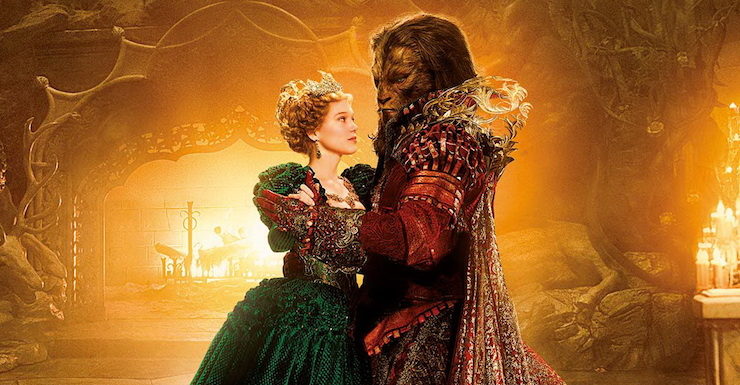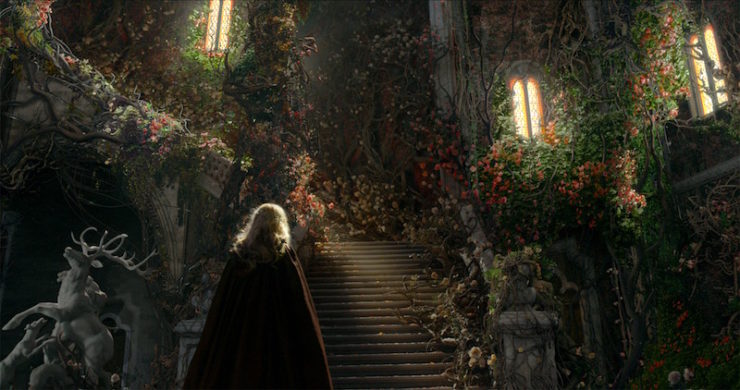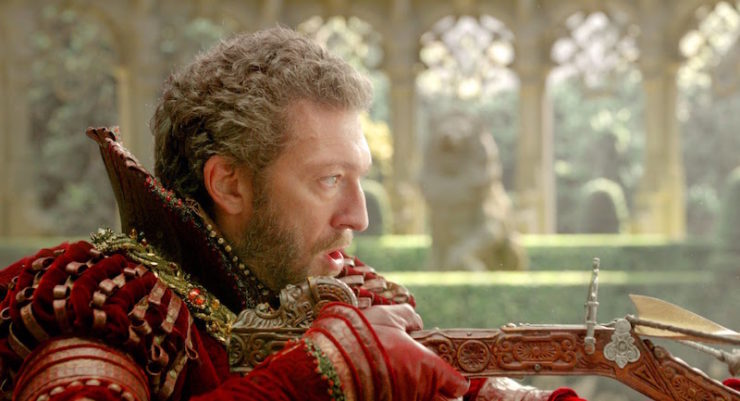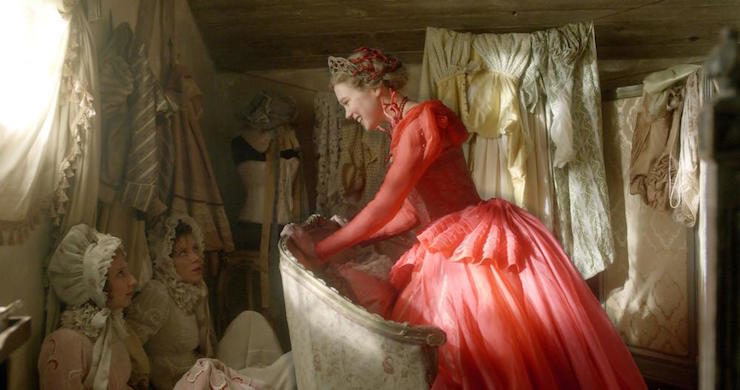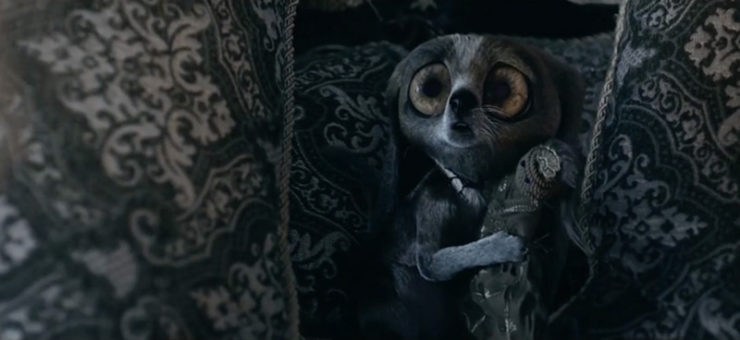As we all—well, at least some of us—prepare to view Disney’s live-action Beauty and the Beast once it arrives on Netflix in just a few more days, I thought it might be fun to look at the other live action adaptation currently available on Netflix: the 2014 Beauty and the Beast, a French-German film starring Lea Seydoux and Vincent Cassel as Belle and the Beast, respectively.
Beauty and the Beast begins with a meta scene acknowledging its own fiction: a woman (no prizes for correctly guessing who she’ll turn out to be) is reading a story to her two children. Some clever camerawork and CGI link the book to the children and then to the tale in the past, as we meet Belle and her family.
For once in film (it happens more frequently in novelizations of the tale) Belle’s siblings are given somewhat individual personalities, partly for plot reasons. Oldest brother Maxime has managed to get involved with a local gang; second brother Jean-Baptiste is an aspiring novelist, and Tristan stands around until the plot needs him to ride a horse or get hit by someone. Older sisters Anne and Clothilde are terribly, terribly upset that their father has lost all of their money, forcing them to go into the country. They aren’t actively cruel to Belle, but they aren’t exactly sensitive, either.
It’s at about this point that the movie starts to go wrong, primarily because someone decided it needed to be longer, and needed a villain not involved with Belle or the Beast, and therefore needed to spend a significant amount of time on a sideplot focused on Maxime, the gang, the gang leader and a tarot card reader. This all does eventually have something to do with the final plot, but it also means that the film spends much less time with Belle and the Beast, much to the film’s later detriment.
Eventually, the film gets us back to the traditional story, as Belle’s father finds himself in a terrible snowstorm, forced to find shelter at the Beast’s castle—AFTER HE ABANDONS HIS STILL LIVING IF INJURED HORSE IN THE SNOW TO FREEZE TO DEATH like if you want me to cheer on a character, film, this may not be the way to do it. Already established as not the greatest guy, he proceeds to show that he has terrible table manners, not to mention that he’s the sort of guy who won’t hesitate to steal roses. Possibly not the sort of father you really need to rescue. But Belle, after reminding us that her mother died in childbirth, decides she can’t have both parents dying on her behalf—and heads straight to the castle to take her father’s place in a visually spectacular wonderland.
The castle and its immediate, enchanted surroundings are drenched in color—I suspect quite a bit of computer work here, along with the more obvious CGI for the moving, shifting vines and the enchanted creatures—but regardless of how the film got here, it looks spectacular: nearly every shot could be used as an illustration for a high fantasy or fairy tale. The Beast and the castle give Belle increasingly impractical if straight from fairy tale dresses to wear, and she begins to explore the castle and the lands of the Beast.
At this point, I rather expected the story to take the traditional route of Beauty and the Beast falling in love, learning not to judge by appearances, even if those appearances include imprisoning you, and the film sorta does, abandoning—for a short time—the whole gangster plot for a magical exploration of an enchanted land and dreams and cute transformed dogs, not to mention a dance between Beauty and the Beast. It also draws from the earlier, longer version of Beauty and the Beast by Gabrielle-Suzanne Barbot de Villeneuve, by including dreams that let Belle know the history of the Beast. SPOILER ALERT he was kinda awful.
The Beast’s backstory takes a decided turn here: rather than a prince who found himself the innocent victim of tangled fairy plots (as in the original French version) or a prince who was rude that one time to a lovely Enchantress (as in the Disney version), in this film, without spoiling too much, I can say that yeah, he kinda does deserve to be trapped in a castle, transformed into a Beast. Not that this has improved him in the slightest: he yells at Belle (who snaps back; this is a Belle with some spirit), enters her bedroom without asking and at one point seems on the verge of raping her, stopped only when the ice cracks beneath them.
This makes it rather harder than usual to cheer on the romance between Belle and the Beast. To be frank, I spent about as much time wondering why he was falling in love with her, besides the wow, Léa Seydoux, the actress portraying her, is a stunningly beautiful woman.
Still, BIG UNEXPECTED SPOILER (ok perhaps not all that unexpected) the Beast turns back into a man after some fun with stone giants and angry plants. But not quite a prince. The film never really explains how, since the next scenes show Belle and the transformed Beast living in the country house with her father and her two children. Belle explains that her three brothers have gone into publishing—not exactly the career I would have predicted for Maxime the thug, but ok—and her two sisters have married identical twins. Her father now sells flowers; the Beast works in the garden, which now features roses instead of pumpkins. This is all very nice if quite a shift from the original French tales, half the point of which was to assure readers that yes, a true prince could be hiding beneath the fur of a vicious looking beast—or man.
It’s still a bit odd, however, given the way that the film adds various touches from other fairy tales—Belle grows large if implausibly lightweight pumpkins, for instance (note to the director: it might have been wise to remind the actors in that scene just how much, exactly, pumpkins weigh before filming it, even if this was otherwise a nice touch). The Beast’s castle, inside and out, is surrounded by briars and roses and plants that can injure people trying to get in—or part for the right person or phrase, just as in Sleeping Beauty. The two older sisters seem to be partly taken from Jeanne-Marie LePrince de Beaumont’s version of the tale, and partly from Cinderella—though neither of them are particularly cruel, just foolish and focused on superficial things. Indeed, they seem genuinely fond of their father, and if they later respond to Belle with more than a bit of terror—well, they did think she was dead, and thus, that she could be a ghost.
And I can only wholeheartedly agree with their disapproval of the red dress Belle is wearing just then. Sure, it’s a beautiful, fairy tale dress, but practical it definitely is not, and given that Belle is just about to do a lot of running through the woods and around stone giants and up several flights of stairs, I gotta agree with her sisters that she should perhaps—just perhaps—be wearing something different.
Other scenes seem—well, let us be kind, and instead of using the word “stolen,” try “inspired by” a certain animated film created by a certain very large multimedia company generally represented in popular culture by a mouse. These scenes include the arrival of Belle’s father to the castle, in a scene that not only quotes the earlier film nearly word for word, but also copies the camera angles; the attack by the gangsters on the Beast’s castle; Belle penetrating the Beast’s private rooms in the dark, the Beast terrifying her, and Belle fleeing right into the snow; and yes, a ballroom dance scene between Beauty and the Beast, begun under considerably different circumstances, but also duplicating many of the movements and the camera angles. I am, shall we say, suspicious—even if this film has just a touch more nudity and violence than that certain very large multimedia company tends to put into its animated films.
The largest problem with the film, however, is not its borrowing from other films and tales—indeed, those moments are some of the most effective parts of the film. No, it’s the relationship between Belle and the Beast, coupled with the issue that this Beast is a pretty awful person, to the point where I found myself cheering on the villain, Perducas. (It helped that Perducas was also after two of the other unsympathetic characters in the film, Belle’s father and her brother, Maxime.) Possibly some scenes were cut from an already overly long film, but at no point do we ever see Belle falling in love with the Beast, even when she dreams of his former self. Nor, to be fair, do we ever see the Beast falling in love with Belle.
This is a slight issue when attempting to retell their tale.
Indeed, it reached the point where I found myself wondering why, exactly, Belle was bothering to do anything for her terrible brother, her willing to abandon injured animals in the snow where they will freeze to death father, or the Beast—though I suppose her willingness to forgive the first two sorta explains how she could fall in love with the last.
The film is, however, gorgeous to look at, drenched in color and CGI and roses. The enchanted little dog things are adorable. The dreamlike elements are pure fairy tale, filled with glorious imagery. Nearly every frame could be a painting from a fairy tale. The actors, if not necessarily convincing as Belle and the Beast, are convincing enough as her siblings and gangsters and a tarot card reader, providing the added bonus of providing plenty of eye candy. If you ignore the love story, and the gangster story, and the back story, and just need something to look at, it might well be worth your time.
Mari Ness lives in central Florida.










